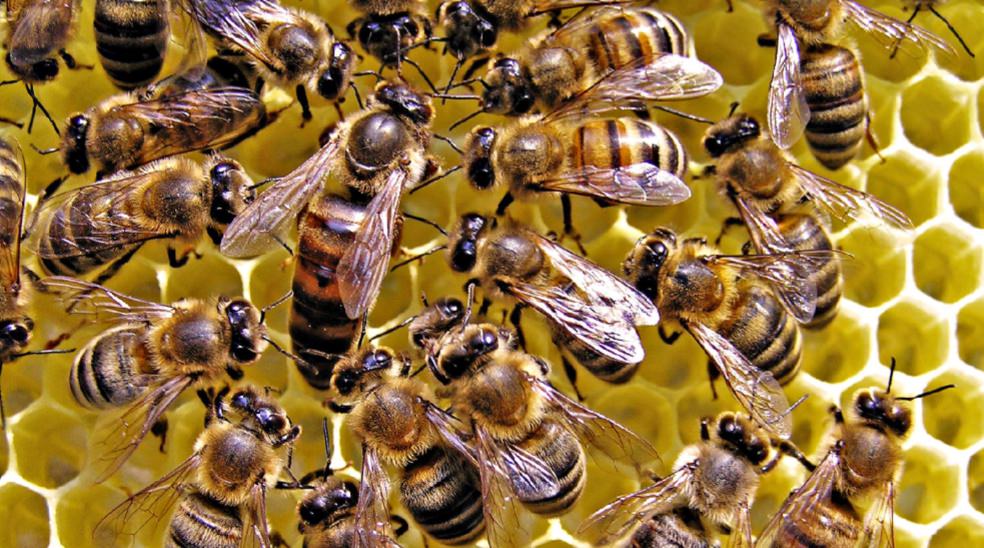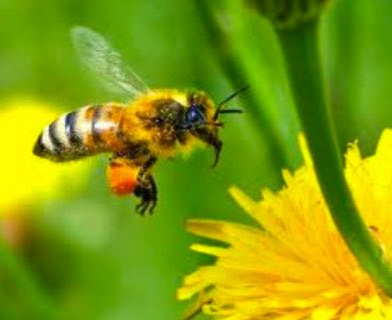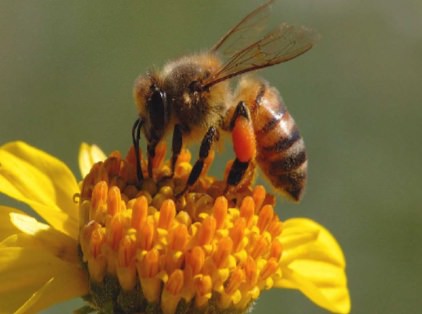The previous report from the Findhorn Apiary was from my great aunt. She hatched last autumn and had the important role, along with about 10,000 of her sisters, of keeping the colony sustained through the winter. She had to help keep the colony warm and the queen fed ready for laying in the spring. Then there was the vital role of raising the next generation. She worked hard and died at the ripe old age of seven months.
My life is somewhat different, there are so many different jobs to do. My first three weeks of life were spent inside the hive. Shortly after emerging from my cell, having had a good meal, I was set to work as a cleaner. It is amazing the amount of rubbish that can collect in a home. Fortunately our beekeepers have supplied hives with mesh floors so a lot of rubbish falls through it, together with varroa mites. However, I soon progressed to polishing cells, getting them ready for the queen to lay an egg in them. That felt really important.

I was then promoted to nurse. When the eggs hatched I was kept very busy feeding the larvae, they eat so much, their weight increases by 700 times from their hatch weight to when they pupate after 6 days. I was even entrusted with feeding the queen.
My final role within the hive was as a house bee. We had to produce wax and build cells with it. That is really hard work because we have to raise our body temperature to 43C so the wax is soft enough to mould. Other duties included processing and storing nectar and honey, ventilating the hive and distributing water to where it is needed.
Sometimes our beekeepers would come to see how we were getting on, looking through the glass ceiling of our hive. However, I don’t think they really know what we are all doing!
After three weeks I was promoted again, this time to guard duty. At last I can see outside our hive. We patrol the entrance, stopping bees from other hives, or sometimes wasps, coming in and robbing our honey. We can detect the queen’s pheromone on a bee and know if they are not from our hive. However, some bees, especially the drones, get up to devious ways of blagging their way in. We do what we can!
We also help our foraging sisters find the way home by releasing a pheromone from our nasonov gland which is near our sting. So if you see us standing with our bottoms in the air and flapping our wings, that is what we are doing.
From our hive we can see the giant whirring white blades of three ‘windmills’. We have heard people ask our beekeepers what we think of them. Perhaps we are too busy to really notice them. Then came the great day of becoming a forager. We explore the area, sometimes flying two miles, or more, from our hive, looking for good supplies of nectar. We have to carefully note features around our hive so that we know the way home. We also register where the sun is and its movement, so we have a sort of compass to navigate by. I thought that would be difficult but it seems to come naturally. When we find a plentiful source of nectar, we can tell our other foraging sisters inside the hive. We do a dance which gives them the ‘compass’ bearing and distance.
We are blessed with many productive gardens around Findhorn, so usually we do not have to fly too far. There is also, close to us, a bountiful supply of heather which produces delicious honey. I have probably said enough and I am very tired. I am now nearly seven weeks old and I expect very soon I will not have the energy to make it home from a foraging trip. It has been a demanding life but hopefully I have helped our colony prosper.
If you are fortunate enough to sample some of our honey, you can now picture something of the work that has gone into producing it. Goodbye.


















A bee’s view of life at the Findhorn Apiary August 21
The previous report from the Findhorn Apiary was from my great aunt. She hatched last autumn and had the important role, along with about 10,000 of her sisters, of keeping the colony sustained through the winter. She had to help keep the colony warm and the queen fed ready for laying in the spring. Then there was the vital role of raising the next generation. She worked hard and died at the ripe old age of seven months.
My life is somewhat different, there are so many different jobs to do. My first three weeks of life were spent inside the hive. Shortly after emerging from my cell, having had a good meal, I was set to work as a cleaner. It is amazing the amount of rubbish that can collect in a home. Fortunately our beekeepers have supplied hives with mesh floors so a lot of rubbish falls through it, together with varroa mites. However, I soon progressed to polishing cells, getting them ready for the queen to lay an egg in them. That felt really important.
I was then promoted to nurse. When the eggs hatched I was kept very busy feeding the larvae, they eat so much, their weight increases by 700 times from their hatch weight to when they pupate after 6 days. I was even entrusted with feeding the queen.
My final role within the hive was as a house bee. We had to produce wax and build cells with it. That is really hard work because we have to raise our body temperature to 43C so the wax is soft enough to mould. Other duties included processing and storing nectar and honey, ventilating the hive and distributing water to where it is needed.
Sometimes our beekeepers would come to see how we were getting on, looking through the glass ceiling of our hive. However, I don’t think they really know what we are all doing!
After three weeks I was promoted again, this time to guard duty. At last I can see outside our hive. We patrol the entrance, stopping bees from other hives, or sometimes wasps, coming in and robbing our honey. We can detect the queen’s pheromone on a bee and know if they are not from our hive. However, some bees, especially the drones, get up to devious ways of blagging their way in. We do what we can!
We also help our foraging sisters find the way home by releasing a pheromone from our nasonov gland which is near our sting. So if you see us standing with our bottoms in the air and flapping our wings, that is what we are doing.
From our hive we can see the giant whirring white blades of three ‘windmills’. We have heard people ask our beekeepers what we think of them. Perhaps we are too busy to really notice them. Then came the great day of becoming a forager. We explore the area, sometimes flying two miles, or more, from our hive, looking for good supplies of nectar. We have to carefully note features around our hive so that we know the way home. We also register where the sun is and its movement, so we have a sort of compass to navigate by. I thought that would be difficult but it seems to come naturally. When we find a plentiful source of nectar, we can tell our other foraging sisters inside the hive. We do a dance which gives them the ‘compass’ bearing and distance.
We are blessed with many productive gardens around Findhorn, so usually we do not have to fly too far. There is also, close to us, a bountiful supply of heather which produces delicious honey. I have probably said enough and I am very tired. I am now nearly seven weeks old and I expect very soon I will not have the energy to make it home from a foraging trip. It has been a demanding life but hopefully I have helped our colony prosper.
If you are fortunate enough to sample some of our honey, you can now picture something of the work that has gone into producing it. Goodbye.